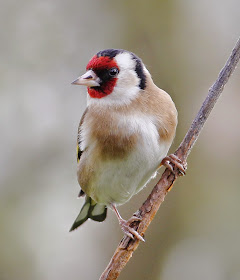The weather forecast was pretty much correct when Andy and I finally made it up to Oakenclough for a ringing session this morning. After an hour or two the wind increased to an unacceptable level so we curtailed the session early, but thankful for the brief window of weather in an otherwise unfriendly week.
We managed a total of just 19 birds, 14 new ones and 5 recaptures only, figures which suggest that many local birds have moved out of the immediate area to pursue their early season breeding and/or territorial desires. Meanwhile the continuing cold weather and northerly winds hold back any migration which might otherwise get under way.
New birds: 4 Goldfinch, 3 Chaffinch, 3 Great Tit and one each of Lesser Redpoll, Robin, Blue Tit and Blackbird.
Blackbird
Recaptures: 2 Goldfinch and one each of Lesser Redpoll, Great Tit and Coal Tit.
Lesser Redpoll
Just last week we heard via the British Trust for Ornithology (BTO) of a couple of Goldfinch recoveries involving the site here at Oakenclough.
Goldfinch
Z355192 a young male Goldfinch we caught at Oakenclough on 30 December had been ringed at Walney Bird Observatory on 19th September 2014, 102 days earlier. Walney lies on the north side of Morecambe Bay, some 35 kms as the Goldfinch flies. In September the Walney folk were unable to sex the Goldfinch so I’m guessing it was a late brooder, but as juvenile birds do, it soon set off to explore the world, or in this case North West England.
Yet another Goldfinch, Y596532 we ringed at Oakenclough on 3rd December 2014 was later the victim of a domestic cat, the Goldfinch found freshly dead in a garden just a mile or two down the road on 30th December. Regrettably this type of recovery is all too common for small birds.
I would urge all cat owners to try to make their own cat a house pet and to not let it wander through gardens or the countryside where it may kill wild animals and birds. If a cat is a dedicated outdoor rambler then it should be fitted with a bell around its neck as a warning device to other animals.
I would urge all cat owners to try to make their own cat a house pet and to not let it wander through gardens or the countryside where it may kill wild animals and birds. If a cat is a dedicated outdoor rambler then it should be fitted with a bell around its neck as a warning device to other animals.
Goldfinch
I see that the first Wheatears plus a “trickle” of Meadow Pipits and “Alba” wagtails arrived on the south coast of England on 3rd March.
It's our turn soon here in the North West - stay tuned to Another Bird Blog to see who, what, when and where.




Beautiful images, my favourite is number 3, superb Goldfinch, thanks Phil.
ReplyDeleteYour photos are gorgeous, Phil! I love seeing all the details. The birds are beautiful.
ReplyDeleteAs for your comment on my yesterday's post, most definitely. I certainly wouldn't thank someone for treating myself or anyone else badly. I think it means to be thankful for everything silently, as each experience we have in life makes us grow.
such handsome birds.
ReplyDeleteExcellent captures of all the birds. The Goldfinch is such a beauty.
ReplyDeleteBeautiful birds and images, Phil! Happy Birding!
ReplyDeleteVery interesting records, Phil. It's sad that cats have to get in the way like that. I think feral cats are making a mess of the place in Australia.
ReplyDeleteThese close up are fabulous Phil.
ReplyDeleteFeral cats and unrestrained house cats are a huge problem. If I have a dog I need to have a licence, keep it on a leash, under my control and in every way ensure that it does not interfere with anyone or anything. I can have a dozen cats if I want and exercise no control over them. I can let them wander the neighborhood at will, kill birds, salamanders, small rodents, dig up people's gardens, poop in their flower beds etc. It is patently ridiculous. Cats are friendly, affectionate, delightful house pets. But that is exactly what they should remain - HOUSE pets, not marauding killers.
ReplyDelete